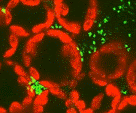Plant Pathology, Department of

Department of Plant Pathology: Faculty Publications
ORCID IDs
0000-0003-3942-6175
0000-0002-4645-1363
0000-0002-7754-7712
Document Type
Article
Date of this Version
2018
Citation
PLoS Genet 14(11): e1007814.
Abstract
Like other intracellular eukaryotic phytopathogens, the devastating rice blast fungus Magnaporthe (Pyricularia) oryzae first infects living host cells by elaborating invasive hyphae (IH) surrounded by a plant-derived membrane. This forms an extended biotrophic interface enclosing an apoplastic compartment into which fungal effectors can be deployed to evade host detection. M. oryzae also forms a focal, plant membrane-rich structure, the biotrophic interfacial complex (BIC), that accumulates cytoplasmic effectors for translocation into host cells. Molecular decision-making processes integrating fungal growth and metabolism in host cells with interface function and dynamics are unknown. Here, we report unanticipated roles for the M. oryzae Target-of-Rapamycin (TOR) nutrient-signaling pathway in mediating plant-fungal biotrophic interface membrane integrity. Through a forward genetics screen for M. oryzae mutant strains resistant to the specific TOR kinase inhibitor rapamycin, we discovered IMP1 encoding a novel vacuolar protein required for membrane trafficking, VATPase assembly, organelle acidification and autophagy induction. During infection, Δimp1 deletants developed intracellular IH in the first infected rice cell following cuticle penetration. However, fluorescently labeled effector probes revealed that interface membrane integrity became compromised as biotrophy progressed, abolishing the BIC and releasing apoplastic effectors into host cytoplasm. Growth between rice cells was restricted. TOR-independent autophagy activation in Δimp1 deletants (following infection) remediated interface function and cell-to-cell growth. Autophagy inhibition in wild type (following infection) recapitulated Δimp1. In addition to vacuoles, Imp1GFP localized to IH membranes in an autophagy-dependent manner. Collectively, our results suggest TOR-Imp1-autophagy branch signaling mediates membrane homeostasis to prevent catastrophic erosion of the biotrophic interface, thus facilitating fungal growth in living rice cells. The significance of this work lays in elaborating a novel molecular mechanism of infection stressing the dominance of fungal metabolism and metabolic control in sustaining long-term plant-microbe interactions. This work also has implications for understanding the enigmatic biotrophy to necrotrophy transition.


Comments
© 2018 Sun et al.
Open access
https://doi.org/10.1371/journal.pgen.1007814